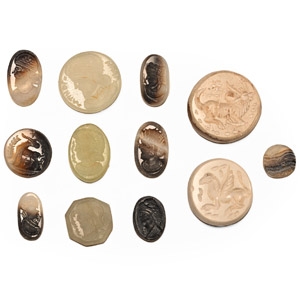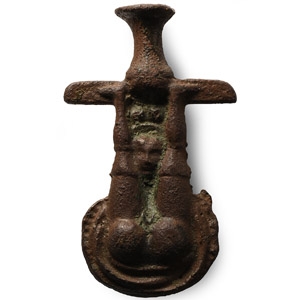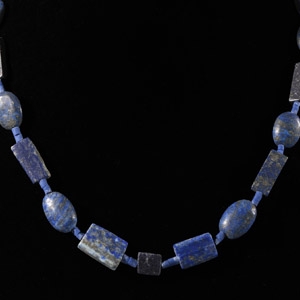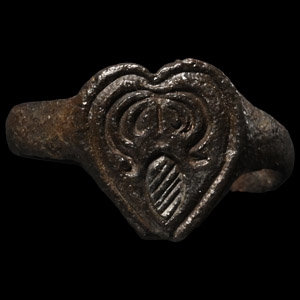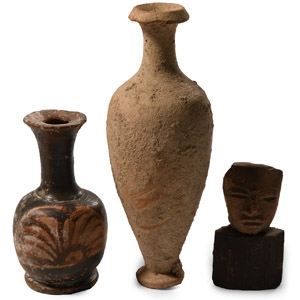With two lines of a poem, permitting a view into a grand architectural setting, populated by falconers, musicians, attendants and others entertaining a prince seated beneath a pagoda, hilly landscape beyond the walls, broad stylised floral border to three sides, Indian workmanship; mounted in a reveal and a glazed wooden frame. 782 grams, 38.6 x 25.5 cmVery fine condition.
Acquired on the UK art market, 1980s-1990s.
The Woodbridge collection of Indo-Persian art.
Comprising mainly glazed vessels and fragments including chamber pots, juglets, tripod pouring jugs, bowls with pierced work decoration and others; together with an almost complete vessel in fragments and a pewter tankard. 12.5 kg total, 5.5-26 cm
Acquired 1990s-early 2000s.
East Anglian private collection.
With flared mouth and bulbous body, low-relief frieze of workers and labourers undertaking appropriate agricultural tasks, horizontal bands with the corresponding names of the months. 4.2 kg, 54 cm high
Acquired London, UK.
Property of a Harwich gentleman.
Restrung; composed of translucent blue glass beads formed of reused glass bangle fragments, interspersed with umber-coloured spacer beads. 11.5 grams, 76 cm long
UK gallery, early 2000s.
Mainly discoid and ellipsoid cloisons with intaglio designs including mythical beast, profile bust and other types. 17 grams total, 9-21 mm
Acquired on the UK art market.
Property of a North London, UK, gentleman.
Bifacial handle showing a woman bent down with her head between her legs, dress pulled up to her waist exposing her naked buttocks. 75 grams, 66 mm
From an old private collection of Norfolk, UK, gentleman, formed since 1998.
Restrung group of beads, mainly tubular, tabular and square-section types with scaraboids. 35.7 grams, 43.5 cm
London, UK, art market, 1980-2000s
Comprising blue and white glazed floral and geometric schemes. 4.76 kg total, 13 x 13 - 13.5 x 13.5 cm
Acquired 1990s-early 2000s.
East Anglian private collection.
With a D-section hoop supporting a heart-shaped bezel displaying a pinecone with foliage above. 2.73 grams, 20.01 mm overall, 16.51 mm internal diameter (approximate size British L, USA 5 3/4, Europe 11.24, Japan 10)
Private collection formed since the 1940s.
UK art market.
Property of an Essex, UK, gentleman.
Comprising various designs in differently coloured glazes, including animals, still life, figural scenes, floral and vegetal motifs, sailing vessels and architectural subject matter. 4.2 kg total, 10.5 x 12.8 - 13.5 x 13.5 cm
Acquired 1990s-early 2000s.
East Anglian private collection.
Including a juglet with trumpet-shaped mouth and a cycladic-type head mounted on a wooden stand. 138 grams total, 5.2 -11.8 cm
From the family collection of a Maida Vale lady, UK.
Comprising: a medieval stone mason's chisel; two post medieval foot pattens (17th-18th century A.D.) for an adult and a child, composed of a ring with extended tongue fitted with iron rivets used to secure the ring to a wooden platform; a 16th-17th century two prong fork with handle replacement; mounted on a backing board. 563 grams total, 15-18.5 cm
From the collection of the famous author, writer and speaker, Gordon Bailey, Essex, UK; formed since 1968.
Cf. Bailey, G., Detector finds 2, Witham, 1993, pp.55-57, for similar foot pattens; Bailey, G., Detector finds 7, Witham, 2011, p.37, for a similar fork.
Bailey, G., Detector finds 5, Witham, 2002, fig.1, p.6, for the Medieval iron chisel.
Iron pattens first came into use probably in 17th century A.D., and gained popularity by the first half of this century. The original design of the patten was that of one piece of shaped wood, but this evolved into to a wooden platform attached to the underside of an iron ring. The foot pattens were forerunners of the Wellington boot which came into use in 19th century A.D.

.jpg)

.jpg)
.jpg)
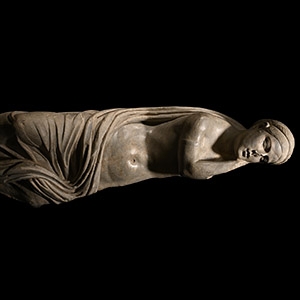
.jpg)
.jpg)

.jpg)
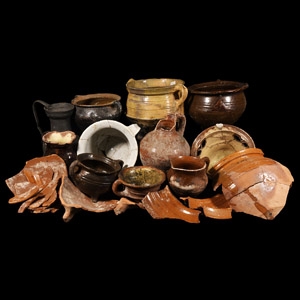
.jpg)
.jpg)
